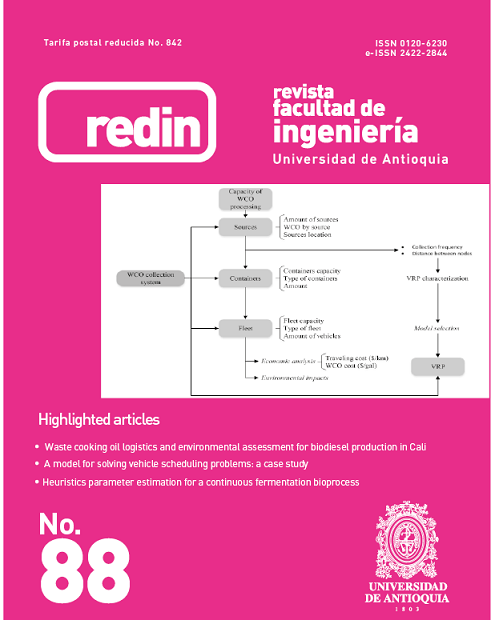Waste cooking oil logistics and environmental assessment for biodiesel production in Cali
DOI:
https://doi.org/10.17533/udea.redin.n88a02Keywords:
biomass, biodiesel, MILP, sustainable developmentAbstract
The present article analyzes different strategies for collecting Waste Cooking Oil (WCO) to produce biodiesel in Santiago de Cali. The quantitative and qualitative analysis of the models found in the literature highlighted the main characteristics for developing a WCO collection model considering the local parameters. Initial results showed that there is not enough WCO to satisfy the demand. However, an improved scenario is proposed following a supply point’s densification strategy. The improved scenario not only fulfills the plant’s installed capacity but also achieved WCO collection cost of 695.5 COP per gallon. 304 gallons of biodiesel could be produced with the collected WCO achieving a potential reduction of 230.81 kg of CO2 if this biodiesel is used to replace the same amount of diesel in the market, due to the difference between the CO2 emissions factor of diesel [kg CO2/diesel gal] and biodiesel [kg CO2/biodiesel gal].
Downloads
References
J. Echavarría, “El desarrollo sostenible y el reciclaje del aceite usado de cocina a la luz de la jurisprudencia y el ordenamiento jurídico colombiano,” Producción + limpia, vol. 7, no. 1, pp. 109–122, 2012.
ASOGRASAS. (2017) asograsas. Accessed Jan. 31, 2017. [Online]. Available: http://www.asograsas.com/
Concejo de Bogotá. (2012). [Online]. Available: http://www.alcaldiabogota.gov.co/sisjur/normas/Norma1.jsp?i=45921
T. R. Pereira, M. I. Gomes, and A. P. Barbosa, “Planning waste cooking oil collection systems,” Waste Management, vol. 33, no. 8, pp. 1691–1703, Aug. 2013.
Y. Zhang, Y. Jiang, M. Zhong, N. Geng, and D. Chen, “Robust optimization on regional WCO-for-Biodiesel supply chain under supply and demand uncertainties,” Scientific Programming, vol. 2016, no. 1, pp. 1–15, Jan. 2016.
H. Zhang, A. Ozturk, Q. Wang, and Z. Zhao, “Biodiesel produced by waste cooking oil: Review of recycling modes,” Renewable and Sustainable Energy Reviews, vol. 38, pp. 677–685, Oct. 2014.
A. Singhabhandhu and T. Tezuka, “Prospective framework for collection and exploitation of waste cooking oil as feedstock for energy conversion,” Energy, vol. 35, no. 4, pp. 1839–1847, Apr. 2010.
D. Aksen, O. Kaya, F. S. Salman, and Y. Akca, “Selective and periodic inventory routing problem for waste vegetable oil collection,” Optimization letters, vol. 6, no. 6, pp. 1063–1080, Aug. 2012.
C. Caldeira, J. Queirós, and F. Freire, “Biodiesel from waste cooking oils in portugal: alternative collection systems,” Waste and Biomass Valorization, vol. 6, no. 5, pp. 771–779, Oct. 2015.
Y. Jiang and Y. Zhang, “Supply chain optimization of biodiesel produced from waste cooking oil,” Transportation Research Procedia, vol. 12, pp. 938–949, 2016.
Downloads
Published
How to Cite
Issue
Section
License
Copyright (c) 2018 Revista Facultad de Ingeniería Universidad de Antioquia

This work is licensed under a Creative Commons Attribution-NonCommercial-ShareAlike 4.0 International License.
Revista Facultad de Ingeniería, Universidad de Antioquia is licensed under the Creative Commons Attribution BY-NC-SA 4.0 license. https://creativecommons.org/licenses/by-nc-sa/4.0/deed.en
You are free to:
Share — copy and redistribute the material in any medium or format
Adapt — remix, transform, and build upon the material
Under the following terms:
Attribution — You must give appropriate credit, provide a link to the license, and indicate if changes were made. You may do so in any reasonable manner, but not in any way that suggests the licensor endorses you or your use.
NonCommercial — You may not use the material for commercial purposes.
ShareAlike — If you remix, transform, or build upon the material, you must distribute your contributions under the same license as the original.
The material published in the journal can be distributed, copied and exhibited by third parties if the respective credits are given to the journal. No commercial benefit can be obtained and derivative works must be under the same license terms as the original work.










 Twitter
Twitter